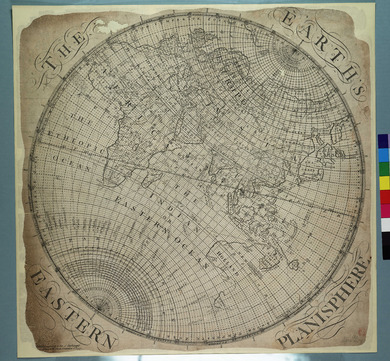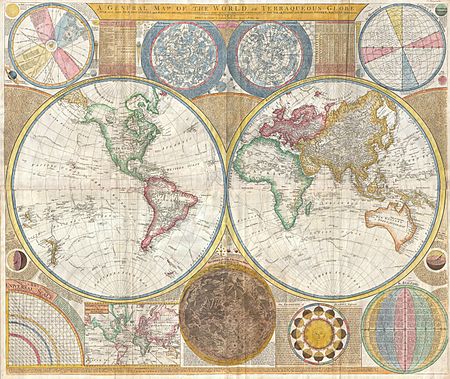Samuel Dunn (mathematician) facts for kids
Quick facts for kids
Samuel Dunn
|
|
|---|---|
| Born | 1723 Crediton
|
| Died | 1794 London
|
| Burial place | London |
| Nationality | British |
| Occupation |
|
| Spouse(s) | Elizabeth Harrison (married 1763) |
Samuel Dunn (1723 – 1794) was a talented British mathematician, teacher, mapmaker (cartographer), and amateur astronomer. He was known for creating detailed maps and teaching important skills like navigation.
Contents
Who Was Samuel Dunn?
Samuel's Early Life
Samuel Dunn was born in Crediton, England, in 1723. Even when he was very young, around 20 years old, he was already teaching. He ran a school where he taught writing, math, and navigation. Navigation is the science of planning and controlling the path of a ship or aircraft.
In 1743, a big fire happened in Crediton. After the fire, Samuel moved his school to a different building. He continued teaching there until the end of 1751.
Moving to London and New Inventions
In December 1751, Samuel Dunn moved to London. There, he taught in different schools and gave private lessons. He was very creative and in 1757, he invented something called "universal planispheres." These were like flat maps of the Earth and the sky.
He made four large maps that showed the Earth and stars in a special way. They came with a clear, see-through tool that helped people solve problems in geography, astronomy, and navigation easily. You could use them without needing a ruler or compass!

In 1758, Samuel became the head of a special school in Chelsea. This school, called the Maritime Academy, helped young people learn important subjects like arts, sciences, and languages. It even had its own observatory for studying the stars.
Discoveries and Important Works
Samuel Dunn was always observing and learning. On January 1, 1760, he watched a special comet. He shared many of his discoveries with the Royal Society, a famous group of scientists. Between 1761 and 1771, he wrote nine papers for their scientific journal, the Philosophical Transactions of the Royal Society. He was also a member of the American Philosophical Society in America.
In 1763, Samuel Dunn married Elizabeth Harrison. Later that year, he left the school in Chelsea and moved to Brompton Park. He continued to give private lessons there. In 1764, he even took a short trip through France.
By 1774, Samuel was living in Clement's Inn in London. This is when he published one of his most important works: his New Atlas of the Mundane System. An atlas is a book of maps. This atlas was beautifully made with 62 copper plates, which are special metal sheets used for printing detailed images.
Because of his great reputation, the East India Company asked him to be a mathematical examiner. This meant he would test people who wanted to work for the company to make sure they knew their math.
The East India Company also helped him publish several of his major books. These included guides for sailors and books about astronomy and navigation. Some of his famous works were:
- A New and General Introduction to Practical Astronomy (1774)
- The Navigators Guide to the Oriental or Indian Seas (1775)
- A New Epitome of Practical Navigation (1777)
- The Theory and Practice of the Longitude at Sea (1778)
He also helped update a very important guide called A New Directory for the East Indies. This book was a huge help for sailors traveling to Asia. Samuel Dunn lived in different parts of London, including Covent Garden and Fleet Street, where he stayed for the rest of his life.
Samuel's Later Life and Legacy
Samuel Dunn passed away in January 1794. In his will, he described himself as a "teacher of the mathematics and master for the longitude at sea." He left money to several family members.
He also made a special request for the town of Crediton. He wanted them to always have a teacher for the school at Bowden Hill. This teacher had to be from the Church of England, but not a priest. They needed to be good at teaching writing, navigation, how to find longitude at sea, drawing, surveying, and all kinds of math. Longitude is a way to measure how far east or west a place is.
For this purpose, he left £30 a year to the school. Six boys were to be taught there, with a special preference for his own relatives. This school became known as Dunn's School.
What Samuel Dunn Published
Samuel Dunn wrote many books and created numerous maps and charts. Here are some of his other published works:
- A Popular Lecture on the Astronomy and Philosophy of Comets (1759)
- Improvements in the Doctrine of the Sphere, Astronomy, Geography, Navigation, &c. (1765)
- A Determination of the exact Moments of Time when the Planet Venus was at external and internal contact with the Sun's Limb, in the Transits of 6 June 1761 and 3 June 1769 (1770)
- An Introduction to the Theory and Use of the Pantographer (1774)
- A New Atlas of Variations of the Magnetic Needle (1776)
- The Description and Use of a New and Easy Formula (1777)
- A New and Easy Method of finding the Latitude on Sea or Land (1778)
- Nautical Propositions and Institutes (1781)
- An Introduction to Latitude, without Meridian Altitudes; and Longitude, at Sea (1782)
- The Linear Tables described, and their utility verified (1783)
- Lunar Tables, Nos. 1–5 (1783)
- A new Formula for Latitude (1784)
- Formulas for all parts of Navigation (1784)
- General Magnetic and True Journal at Sea (1784)
- Magnetic and true Journal at Sea (1784)
- Rules for a Ship's Journal at Sea (1784)
- Ship's Journal at Sea (1784)
- A Table for Transverses and Currents (1784)
- Tables of Correct and Concise Logarithms (1784)
- Precepts, Formulas, Tables, Charts, and Improvements (1784)
- Nautic Tables (1785)
- Tables of Time and Degrees, and hourly change of the Suns right Ascension (1786)
- A Description of peculiar Charts and Tables for facilitating a Discovery of both the Latitude and Longitude in a Ship at Sea (1787)
- Linear Tables, one, two, three, four, and five, abridged, &c. (1788)
- Linear Table xvi. for showing the Suns Declination (1788)
- The Lunar Method Shortend in Calculation & Improv'd (1788)
- A Navigation Table for shortening days works (1788)
- The Longitude Journal; its description and application (1789)
- The Sea-Journal improved, with its description (1789)
- The Daily Uses of Nautical Sciences in a Ship at Sea (1790)
- An Introduction to the Lunar Method of Finding the Longitude in a Ship at Sea (1790)
- A New Directory for the East Indies, 6th edition (1791)
- The Astronomy of Fixed Stars, concisely deduced from original principles, and prepared for application to Geography and Navigation, Part I. (1792)
- Improvements in the Methods now in use for taking the Longitude of a Ship at Sea (1793)
- The Longitude Logarithms (1793)


